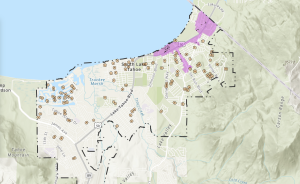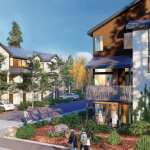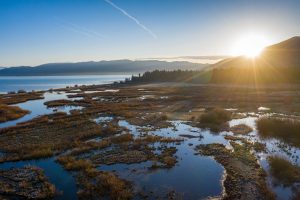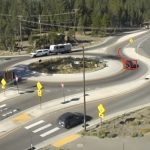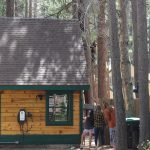First wave of VHR permit approvals leave some unsatisfied
SOUTH LAKE TAHOE, Calif. – Last Saturday marked the end of the first wave of vacation home rental (VHR) applications for preferred permit holders, where 95 permits were ultimately approved. But several applicants found themselves confused by the process and worry about how the general application period will play out, especially with the new 150-foot buffer in place.
Preferred applicants were previous VHR permittees in good standing whose permits expired in 2021 and were not renewed due to Measure T, and previous QVHR permittees in good standing whose permits became void in April 2025 after the court’s ruling in the Measure T lawsuit. These applicants were allowed to apply from Monday, June 23 to Saturday, August 23.
The city of South Lake Tahoe provided information on its website, which specified that it was possible to be buffered out, stating: “If there is an application deemed complete ahead of yours that is within your 150-foot buffer and receives a permit while your application is pending, you will not be eligible to receive a permit and your application will be denied.”
A VHR buffer zone map was also provided for applicants to see where issued permits fell on the map.
The South Lake Tahoe Police Department provided VHR manager Ashley Galdi with some staff members to support with taking in, reviewing and facilitating the application process, but the Tribune did not receive a response on how many staff members were specifically working on VHR permits.
While the city provided these resources, VHR applicants, especially those who live out of town, felt that the communications were unclear and that the first-come, first-served model was hard for them to deal with. Some described it as “chaotic and totally unorganized,” while others said it was a “total disaster” for them.
Robert Mazzetti, who applied in late July, said he paid his application and inspection fees in late July. However, a neighbor within the 150-foot buffer completed the inspection before he did, barring him from completing the next steps.
Mazzetti received an email stating that he would be issued a refund for both application and inspection fees on July 28th, then was told three days later that he would only receive a refund for the inspection, as “services were not preformed [sic]”.
As far as refunds go, Galdi told the Tribune that the city advised the public to monitor the city website for updates on the process. The FAQ section on the city website now specifies that application fees are non-refundable if payment is made upon receiving the initial “Balance Due” email.
“I thought my application was accepted and I just needed to pass the inspection. I would never have applied if I knew I might lose $548.00 for a permit fee,” said Mazzetti.
Mazzetti also said he wasn’t able to see the map on the website until July 31, although the VHR department told the Tribune in an email that the map was up on the website and updated hourly. The syncing for the public map did experience a technical issue, but a fix was implemented the same day.
Other VHR permit holders gave their complaints during public comment to city council. Brad Adams, a Folsom resident said that he knew it was a first-come, first-served process. “But what I did not understand is that this applied even after our permit was accepted, deemed accepted and fees were paid.”
Adams scheduled his inspection for August 8, but was told a few days before that someone else within the buffer had been approved before him and that he would be denied the permit.
Some applicants complained that it was difficult to verify their previous permits, as the city changed over how the permits were numbered. This caused delays for some who entered their numbers the way they’d previously been set up, only to hear back from the city that their permit was incomplete or incorrectly filled out.
Mazzetti said that the city was unable to find his old permit, but he had luckily scanned it into his computer. “This may have delayed me getting an inspection,” he said.
Others also complained that they had submitted their applications, then saw others receive permits before they got theirs. Galdi told the Tribune that the applications were timestamped automatically by the online system and were reviewed in the order received. However, VHR applicants were not privy to where they fell in the queue.
Communications from the VHR department were reportedly slow due to their focus on the applications rather than other communications.
Before the preferred deadline arrived, people urged city council to either remove the buffer, eliminate the buffer for preferred permit applicants or extend the deadline. These asks were not publicly responded to, and now the deadline has passed.
Roughly 450 people who had previously owned VHRs and hadn’t sold those homes would have been eligible to apply for a new permit. But the city specified it wouldn’t approve more than 150 permits per month.
Now, according to police chief Jeff Roberson, 95 permits in total were approved during this preferred period. Five of those were QVHR holders, though more who didn’t qualify for the specific terms or simply did not apply during the preferred period may send in applications.
It wasn’t rough waters for every applicant—some had smooth sailing. Still, the conflict and friction could come down to another legal battle, considering the continued appeal to the ruling on Measure T and the sticking point of the effect of VHRs on the city’s character and economics.
VHR applications are now open to the general public. Assistant city manager Hilary Roverud said in an email to the Tribune that the city anticipates that after review of the initial wave of applications, the workload will require less staff and third-party contract resources, but future staffing for the VHR department would be evaluated as needed.
Eli Ramos is a reporter for Tahoe Daily Tribune. They are part of the 2024–26 cohort of California Local News Fellows through UC Berkeley.

Support Local Journalism

Support Local Journalism
Readers around the Lake Tahoe Basin and beyond make the Tahoe Tribune's work possible. Your financial contribution supports our efforts to deliver quality, locally relevant journalism.
Now more than ever, your support is critical to help us keep our community informed about the evolving coronavirus pandemic and the impact it is having locally. Every contribution, however large or small, will make a difference.
Your donation will help us continue to cover COVID-19 and our other vital local news.

